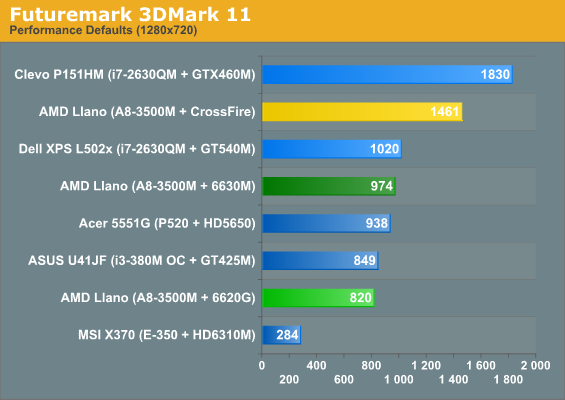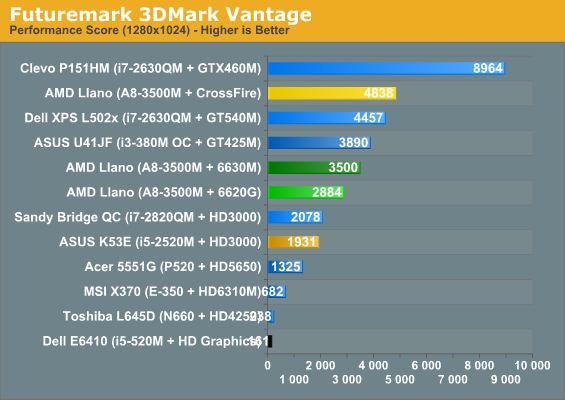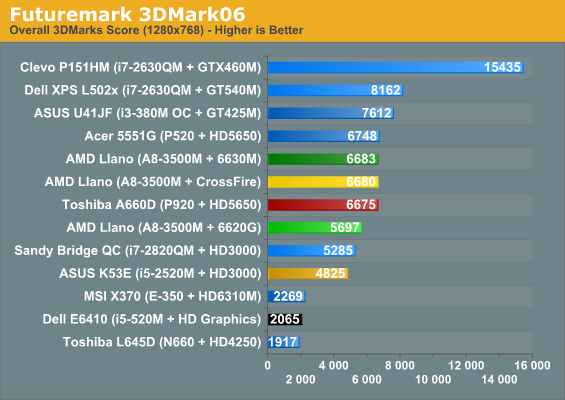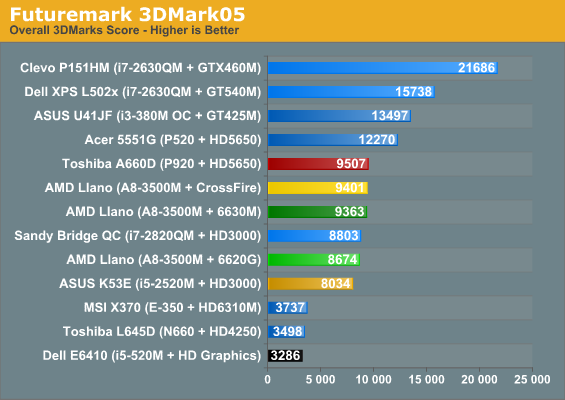The AMD Llano Notebook Review: Competing in the Mobile Market
by Jarred Walton & Anand Lal Shimpi on June 14, 2011 12:01 AM ESTFusion GPUs: A Long-Awaited Upgrade to IGPs Everywhere
During our conversations with AMD, at one point they mentioned that they prefer not to use the term “IGP” anymore since they consider it a derogatory term. I asked what we should call Llano’s graphics and they said AMD officially refers to it as the “Fusion GPU” (fGPU), so that's what we'll use going forward. Regardless of what we call it, though, there’s no doubt that the 6620G fGPU is a dramatic upgrade to the old HD 4250; in fact, the 6620G should also boast significantly better performance than Intel’s HD 3000…provided the CPU core doesn’t become a bottleneck. Let’s start with 3DMark comparisons to see just where Llano falls. Again, we have the 6620G and 6630M Llano setups tested, but now we’re adding CrossFire to the mix.






I’m including all of the 3DMark iterations to provide a broad view of graphics potential. The latest 3DMark11 release seems to be almost purely GPU-limited, but of course it requires DX11 support and thus many of the other laptops (including Intel’s IGP) fail to run it. 3DMark Vantage’s Performance defaults are about as demanding, and Llano comes out 40-50% ahead of Sandy Bridge’s HD 3000. Of course, Arrandale completely falls on its face in the Performance test, generating a result of just 161, but AMD’s old HD 4250 is only marginally better with a score of 238. Remove some of the demands with the Vantage Entry-Level preset and Sandy Bridge starts to close the gap, with the quad-core 2820QM actually coming out ahead of Llano. Things that make you go hmm….
Things don’t get any better when we look at Asymmetrical CrossFire (ACF) from Llano. 3DMark11 comes in a whopping 50% faster than the 6630M dGPU, or 78% faster than the fGPU. If that performance boost showed up in our games, things would be great, but unfortunately it doesn’t. AMD informed us just yesterday that only DX10 or DX11 games and applications will even work with ACF, so perhaps that explains why we see little to no benefit in 3DMark03/05/06. The Vantage Performance preset shows a respectable 38% increase vs. the dGPU and 68% over the fGPU, but on Entry-Level it’s only 11-14% faster, and in 3DMark03 the dGPU actually scored lower than the fGPU.
If we were to stop our analysis of graphics performance right now, I suspect there would be a lot of confusion. Llano’s fGPU is anywhere from being equal to HD 3000 to 50% faster; Asymmetrical CrossFire is either a boon or a bust. So which is it? This is why we only place a minor emphasis on 3DMarks; let’s get to some actual gaming benchmarks.










177 Comments
View All Comments
JarredWalton - Tuesday, June 14, 2011 - link
Totally agree with the pricing. The highest performance A8 laptops are going to need to be $700 with fGPU only, and maybe $800 with dGPU, because that's where dual-core i5 + Optimus laptops are currently sitting.Of course, I'd still pay more for good build quality and a nice LCD and keyboard.
Oh, and the people saying CPU is the be-all, end-all... well, even though I have a couple Core i7 Bloomfield systems in my house (and many Core i5/i7 laptops), my primary work machine is running... Core 2 QX6700 (@3.2GHz) with an HD 5670 GPU and 4GB RAM. The area I want to upgrade the most is storage (currently using RAID0 Raptor 150GB), but I have no desire to reformat and start transferring apps to another PC, so I continue to plug along on the Raptors. This CPU is now over four years old, and yet the only thing I really don't like is the HDD thrashing and slow POST times.
ionave - Thursday, June 16, 2011 - link
None of those GPU's match the power of the 6620, which you can find in even the A6 series, so your point is invalid.Dribble - Wednesday, June 15, 2011 - link
Actually you can normally tell quite easily which laptop has the slower cpu. It's the one with the fan whining away. With laptops having a more powerful processor that isn't having to work so hard is important just to keep the thing quiet.As for cpu power - well windows and it's software just isn't that efficient. Even a fairly complex word 2010 doc (few pictures/charts/etc) can start to feel slow on a 2.5Ghz C2D (I should know my laptop has a 2.4Ghz C2D). The flash games my kids seem to be forever finding are also cpu only and will run it flat out and the game won't seem as smooth as it would on a faster machine.
Sure you can get by with a slower machine, but it doesn't make for such a pleasant experience.
It has been the case since PC's arrived that over time software needs more and more power. e.g. I could run word 6 on a 486, I now really need a dual core 2Ghz machine to even run word 2010. I don't see that changing hence the faster your cpu the longer your pc will remain usable.
lukarak - Wednesday, June 15, 2011 - link
I've been using a 2007 tech MacBook white up until a few months ago with a 2.0 GHz C2D. Over time i upgraded it to include 6 GB of memory, a 64 GB SSD + 500 GB HDD, and then i transitioned to a 2011 MPB 13 with a SNB CPU and 4 GB of memory. Aside from a better screen, once i put in the SSD, i couldn't see the diference in speed. I usually use a lot of VM, use Eclipse and XCode, and most of the time watch 720p and the more than 3 years newer CPU isn't all that revolutionary. Sure, it may not use 30ish % of the CPU to play movies, but only 20ish, but until that's 50ish% when the fan gets louder it doesn't really matter for me.ionave - Thursday, June 16, 2011 - link
The CPU looks relatively slow to the i5/i7, but its really not that slow. Seriously. Compare it to an atom and see that its not that bad.ionave - Thursday, June 16, 2011 - link
The CPU isn't even bad. I don't know what you guys are all on but A8 cores are improved phenom II x4 cores... I would say its about the same performance as the i5 series. All the benchmarks online are measured on the WORST A8 chip, which has the worst CPU performance. All of the reviews are on A8-3500M. Just wait until the A8-3850 gets benchmarked.All I'm saying is that its not fair to compare the worst A8 to the best i5 or best i7, plain and simple.
sundancerx - Tuesday, June 14, 2011 - link
for most of the charts, yellow bar is assigned to INTEL asus k53e(i5-2520m+hd3000), but on asymetrical crossfire, this is assigned to AMD llano (18-3500m+crossfire). kind of confusing if you dont pay attention or am i the one confused?JarredWalton - Tuesday, June 14, 2011 - link
Dark yellow = K53E, bright yellow = CrossFire. If you have a different color you think would work, I'll be happy to change it. Purple? Brown? Orange?adrien - Tuesday, June 14, 2011 - link
I agree Brazos looks less interesting now but it still has one huge advantage: price. If Llano notebooks are going to sell for $600 (or $500), Brazos are 40% less expensive.JarredWalton - Tuesday, June 14, 2011 - link
Brazos E-350 (which is already 60% faster than C-50) start at around $425. They come with 2GB RAM and a 250GB HDD. AMD is saying $500 as the target price for A4, $600 for A6, and $700 for A8, but I suspect we'll see lower than that by at least $50. So if your choice is Brazos E-350 for $425 or Llano A4 for $450, and the Llano packs 4GB RAM and a 500GB HDD, there's no competition--though size will of course be another factor. I figure Llano will bottom out at 13.3-inch screens where Brazos is in 11.6" and 12.1". Personally, I'd never buy a 10" netbook; I just can use them comfortably. I'm happiest with 13.3" or 14" laptops.